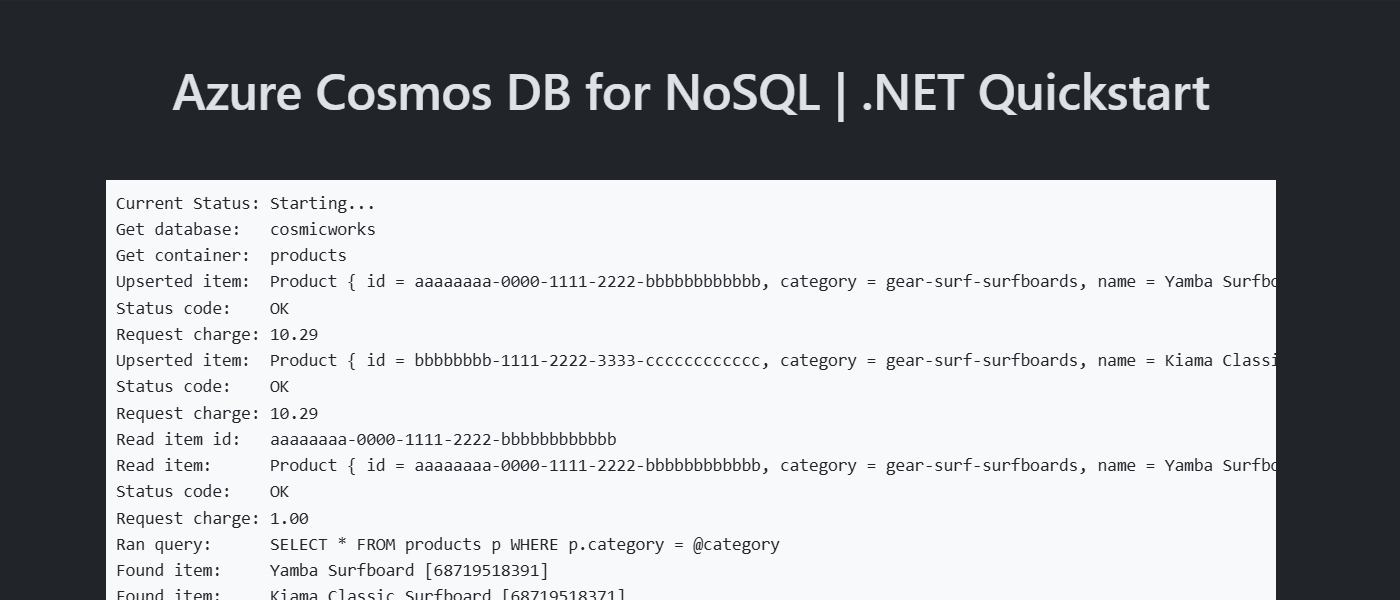Note
Access to this page requires authorization. You can try signing in or changing directories.
Access to this page requires authorization. You can try changing directories.
In this quickstart, you deploy a basic Azure Cosmos DB for NoSQL application using the Azure SDK for .NET. Azure Cosmos DB for NoSQL is a schemaless data store allowing applications to store unstructured data in the cloud. Query data in your containers and perform common operations on individual items using the Azure SDK for .NET.
API reference documentation | Library source code | Package (NuGet) | Azure Developer CLI
Prerequisites
- Azure Developer CLI
- Docker Desktop
- .NET 9.0
If you don't have an Azure account, create a free account before you begin.
Initialize the project
Use the Azure Developer CLI (azd) to create an Azure Cosmos DB for NoSQL account and deploy a containerized sample application. The sample application uses the client library to manage, create, read, and query sample data.
Open a terminal in an empty directory.
If you're not already authenticated, authenticate to the Azure Developer CLI using
azd auth login. Follow the steps specified by the tool to authenticate to the CLI using your preferred Azure credentials.azd auth loginUse
azd initto initialize the project.azd init --template cosmos-db-nosql-dotnet-quickstartDuring initialization, configure a unique environment name.
Deploy the Azure Cosmos DB account using
azd up. The Bicep templates also deploy a sample web application.azd upDuring the provisioning process, select your subscription, desired location, and target resource group. Wait for the provisioning process to complete. The process can take approximately five minutes.
Once the provisioning of your Azure resources is done, a URL to the running web application is included in the output.
Deploying services (azd deploy) (✓) Done: Deploying service web - Endpoint: <https://[container-app-sub-domain].azurecontainerapps.io> SUCCESS: Your application was provisioned and deployed to Azure in 5 minutes 0 seconds.Use the URL in the console to navigate to your web application in the browser. Observe the output of the running app.

Install the client library
The client library is available through NuGet, as the Microsoft.Azure.Cosmos package.
Open a terminal and navigate to the
/src/webfolder.cd ./src/webIf not already installed, install the
Microsoft.Azure.Cosmospackage usingdotnet add package.dotnet add package Microsoft.Azure.Cosmos --version 3.*Also, install the
Azure.Identitypackage if not already installed.dotnet add package Azure.Identity --version 1.12.*Open and review the src/web/Cosmos.Samples.NoSQL.Quickstart.Web.csproj file to validate that the
Microsoft.Azure.CosmosandAzure.Identityentries both exist.
Import libraries
Import the Azure.Identity and Microsoft.Azure.Cosmos namespaces into your application code.
using Azure.Identity;
using Microsoft.Azure.Cosmos;
Object model
| Name | Description |
|---|---|
| CosmosClient | This class is the primary client class and is used to manage account-wide metadata or databases. |
| Database | This class represents a database within the account. |
| Container | This class is primarily used to perform read, update, and delete operations on either the container or the items stored within the container. |
| PartitionKey | This class represents a logical partition key. This class is required for many common operations and queries. |
Code examples
The sample code in the template uses a database named cosmicworks and container named products. The products container contains details such as name, category, quantity, a unique identifier, and a sale flag for each product. The container uses the /category property as a logical partition key.
Authenticate the client
This sample creates a new instance of the CosmosClient class and authenticates using a DefaultAzureCredential instance.
DefaultAzureCredential credential = new();
CosmosClient client = new(
accountEndpoint: "<azure-cosmos-db-nosql-account-endpoint>",
tokenCredential: new DefaultAzureCredential()
);
Get a database
Use client.GetDatabase to retrieve the existing database named cosmicworks.
Database database = client.GetDatabase("cosmicworks");
Get a container
Retrieve the existing products container using database.GetContainer.
Container container = database.GetContainer("products");
Create an item
Build a C# record type with all of the members you want to serialize into JSON. In this example, the type has a unique identifier, and fields for category, name, quantity, price, and sale.
public record Product(
string id,
string category,
string name,
int quantity,
decimal price,
bool clearance
);
Create an item in the container using container.UpsertItem. This method "upserts" the item effectively replacing the item if it already exists.
Product item = new(
id: "aaaaaaaa-0000-1111-2222-bbbbbbbbbbbb",
category: "gear-surf-surfboards",
name: "Yamba Surfboard",
quantity: 12,
price: 850.00m,
clearance: false
);
ItemResponse<Product> response = await container.UpsertItemAsync<Product>(
item: item,
partitionKey: new PartitionKey("gear-surf-surfboards")
);
Read an item
Perform a point read operation by using both the unique identifier (id) and partition key fields. Use container.ReadItem to efficiently retrieve the specific item.
ItemResponse<Product> response = await container.ReadItemAsync<Product>(
id: "aaaaaaaa-0000-1111-2222-bbbbbbbbbbbb",
partitionKey: new PartitionKey("gear-surf-surfboards")
);
Query items
Perform a query over multiple items in a container using container.GetItemQueryIterator. Find all items within a specified category using this parameterized query:
SELECT * FROM products p WHERE p.category = @category
string query = "SELECT * FROM products p WHERE p.category = @category"
var query = new QueryDefinition(query)
.WithParameter("@category", "gear-surf-surfboards");
using FeedIterator<Product> feed = container.GetItemQueryIterator<Product>(
queryDefinition: query
);
Parse the paginated results of the query by looping through each page of results using feed.ReadNextAsync. Use feed.HasMoreResults to determine if there are any results left at the start of each loop.
List<Product> items = new();
while (feed.HasMoreResults)
{
FeedResponse<Product> response = await feed.ReadNextAsync();
foreach (Product item in response)
{
items.Add(item);
}
}
Explore your data
Use the Visual Studio Code extension for Azure Cosmos DB to explore your NoSQL data. You can perform core database operations including, but not limited to:
- Performing queries using a scrapbook or the query editor
- Modifying, updating, creating, and deleting items
- Importing bulk data from other sources
- Managing databases and containers
For more information, see How-to use Visual Studio Code extension to explore Azure Cosmos DB for NoSQL data.
Clean up resources
When you no longer need the sample application or resources, remove the corresponding deployment and all resources.
azd down